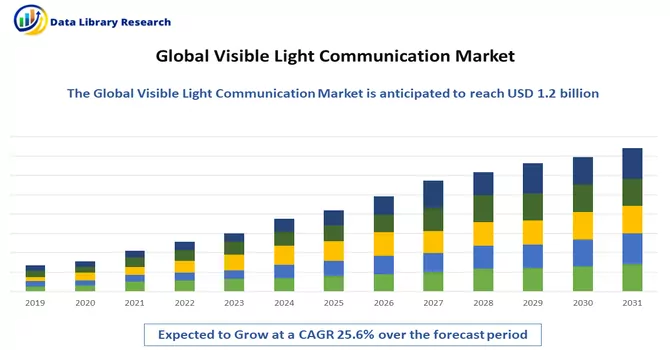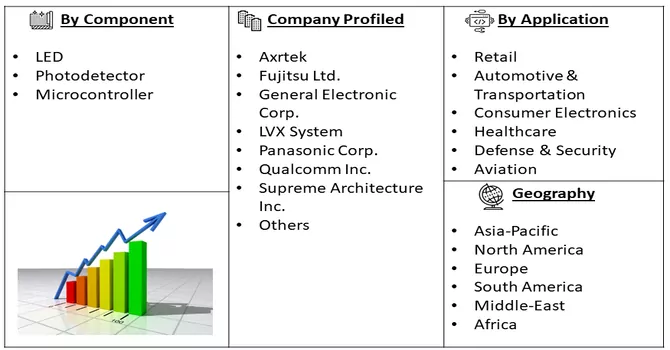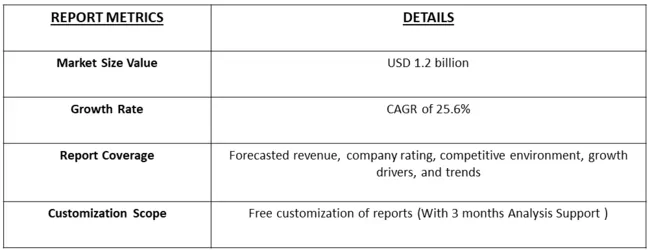The Global Visible Light Communication Market size is projected to grow from USD 1.2 billion in 2023 and expected to register a CAGR of 25.6% during the forecast period, 2024-2031.

Get Complete Analysis Of The Report - Download Free Sample PDF
Visible Light Communication (VLC) is a wireless communication technology that uses light-emitting diodes (LEDs) to transmit data. It works by modulating the intensity of light at a rapid rate that is imperceptible to the human eye. Photodetectors receive the modulated light and convert it back into electrical signals. VLC has several advantages, including high data rates, security (as light cannot pass through walls), and the ability to work in areas where radio frequency (RF) communication is restricted, such as in aircraft cabins, hospitals, and underwater. VLC is used in various applications, including indoor positioning, smart lighting, underwater communication, and vehicle-to-vehicle communication.
The Visible Light Communication (VLC) market is experiencing rapid growth driven by several key factors. Firstly, the increasing demand for high-speed data communication, fueled by the proliferation of smart devices and the Internet of Things (IoT), is pushing the adoption of VLC. With its ability to provide high data rates, VLC is seen as a viable solution to meet this growing demand. Secondly, the rising adoption of LED lighting systems is contributing to the growth of the VLC market. VLC utilizes LED lighting for data transmission, and as LED lighting becomes more popular for its energy efficiency and environmental benefits, the use of VLC is also increasing. Additionally, VLC offers several advantages over traditional wireless technologies, such as Wi-Fi and Bluetooth, including higher data rates, lower interference, and the ability to work in RF-restricted environments. These advantages are driving its adoption in various applications. Moreover, the increasing focus on Li-Fi technology, which is a form of VLC using light for data transmission, is also contributing to the growth of the VLC market. Governments in various countries are also taking initiatives to promote VLC technology, further boosting its growth. Thus, the VLC market is poised for significant expansion as it continues to find applications in diverse industries and benefits from technological advancements.
Market Segmentation: The Visible Light Communication/Light Fidelity Market is Segmented By Component (LED, Photodetector, Microcontroller), Application (Retail, Automotive & Transportation, Consumer Electronics, Healthcare, Defense & Security and Aviation) and Geography (North America, Europe, Asia Pacific, Middle East and Africa, and South America). The market provides the value (in USD million) for the above-mentioned segments.

For Detailed Market Segmentation - Download Free Sample PDF
The Visible Light Communication (VLC) market is evolving with trends such as integration into smart lighting for dual functionality, expansion into retail for indoor navigation, and integration with Li-Fi for faster data rates. Advancements in LED technology are improving VLC system performance, while hybrid communication systems combining VLC with other wireless technologies are emerging. Standardization efforts are increasing, aiming to ensure interoperability and drive market growth. Additionally, VLC's integration with 5G networks is enhancing network capacity and reliability. These trends collectively indicate a dynamic market poised for growth, driven by the demand for high-speed, reliable wireless communication solutions across various industries.
Market Drivers:
Increasing Demand for High-Speed Data Transmission
The rising prevalence of connected devices and the escalating requirement for rapid data transmission rates have generated a surge in demand for advanced technologies like Visible Light Communication (VLC). VLC's capability to deliver high data rates has positioned it as a compelling solution for applications necessitating swift and dependable data communication. This technology utilizes light-emitting diodes (LEDs) to transmit data, offering advantages such as high bandwidth and low latency. As a result, VLC is increasingly being adopted in various sectors, including indoor positioning, smart lighting, and automotive communication systems. The growth of the VLC market is further propelled by its compatibility with existing lighting infrastructure, making it a cost-effective and efficient solution for high-speed wireless communication.
Growing Adoption of LED Lighting
VLC technology leverages LED lighting for transmitting data, benefiting from the widespread adoption of LEDs for their energy efficiency and cost-effectiveness. This adoption trend is a key driver for the growing demand for VLC. As the deployment of LED lighting expands across different environments, the opportunities for implementing VLC also increase. This trend is fueling the growth of the VLC market, as more industries and sectors recognize the benefits of VLC in conjunction with LED lighting. The combination of these technologies not only offers efficient illumination but also provides a robust and versatile platform for high-speed data transmission, contributing to the overall advancement and acceptance of VLC technology in the market.
Market Restraints:
High Implementation Costs
The implementation of VLC technology can incur significant costs, particularly for large-scale deployments. This encompasses the expenses associated with installing LED lighting systems that can effectively support VLC functionality, along with the costs of integrating VLC-enabled devices into existing infrastructures. These costs include not only the hardware expenses but also the expenses related to system design, installation, and maintenance. Additionally, the need for specialized equipment and expertise further adds to the overall implementation costs of VLC technology. These cost considerations can pose a barrier to entry for some organizations, especially those with limited budgets or resources. However, as the technology matures and adoption increases, economies of scale and advancements in technology may help reduce these costs over time, making VLC more accessible to a wider range of applications and industries.
The COVID-19 pandemic has had a mixed impact on the Visible Light Communication (VLC) market. On one hand, the increased focus on health and safety has led to a surge in demand for VLC-enabled technologies for applications such as indoor positioning, occupancy monitoring, and contactless communication, particularly in healthcare facilities, retail stores, and office buildings. On the other hand, the economic slowdown caused by the pandemic has resulted in budget constraints for many organizations, leading to delays or cancellations of VLC deployment projects. Additionally, disruptions in the supply chain and manufacturing processes have also affected the VLC market, causing delays in product development and deployment. However, as the world emerges from the pandemic and economic activities resume, the VLC market is expected to recover, driven by the growing demand for high-speed, secure, and energy-efficient wireless communication technologies across various industries.
Segmental Analysis:
Microcontroller Segment is Expected to Witness Significant Growth Over the Forecast Period
The microcontroller market plays a crucial role in the development and adoption of Visible Light Communication (VLC) technology. Microcontrollers are used in VLC systems to control the modulation and demodulation of the light signals, manage data transmission, and interface with other components of the VLC system. As the demand for VLC technology grows across various industries such as automotive, healthcare, and retail, the microcontroller market is expected to witness significant growth. One of the key drivers for the microcontroller market in the VLC space is the increasing adoption of smart lighting systems. These systems utilize microcontrollers to enable communication through light, offering benefits such as energy efficiency, high data rates, and secure communication. The integration of microcontrollers in smart lighting systems enhances their functionality, enabling them to support VLC technology for data communication alongside illumination. Moreover, advancements in microcontroller technology, such as the development of low-power and high-performance microcontrollers, are further driving the adoption of VLC technology. These advancements enable the implementation of more efficient and reliable VLC systems, expanding the potential applications of VLC across various industries. Thus, the growth of the microcontroller market is closely tied to the expansion of the VLC market, with microcontrollers playing a vital role in enabling the functionality and performance of VLC systems.
Security and Aviation Segment is Expected to Witness Significant Growth Over the Forecast Period
Security is a critical concern in the aviation industry, where safety and communication are paramount. Visible Light Communication (VLC) technology offers several advantages in enhancing security measures within aviation environments. One key application is in aircraft cabin communication, where VLC can provide secure and interference-free data transmission between crew members and passengers. This can be particularly useful during emergencies or when traditional communication channels are unavailable. Another application is in airport security and operations, where VLC can be used for indoor positioning and navigation. By utilizing VLC-enabled devices, airport personnel can accurately track and monitor the movement of passengers and luggage, improving security measures and operational efficiency. Additionally, VLC can enhance the security of airport infrastructure, such as runways and terminals, by providing reliable communication for surveillance systems and access control systems. This can help in preventing unauthorized access and ensuring the safety of airport facilities. Thus, the integration of VLC technology in the aviation industry can significantly enhance security measures, improve operational efficiency, and enhance the overall passenger experience.
North America Region is Expected to Witness Significant Growth Over the Forecast Period
North America is a key region driving the growth of the Visible Light Communication (VLC) market. The region is witnessing increasing adoption of VLC technology across various industries, including retail, healthcare, and automotive, among others. One of the major factors driving the VLC market in North America is the region's strong focus on technological advancements and innovation. North American companies are investing heavily in research and development activities to develop advanced VLC systems and applications, driving market growth. Moreover, the region's robust infrastructure and high internet penetration rates are facilitating the adoption of VLC technology. The presence of advanced lighting infrastructure, such as LED lighting systems, further supports the implementation of VLC for data communication. Additionally, the growing demand for high-speed, secure, and energy-efficient wireless communication technologies is fueling the adoption of VLC in North America. Industries such as healthcare and retail are leveraging VLC technology for applications such as indoor positioning, wayfinding, and inventory management, driving market growth. Furthermore, the presence of key players in the VLC market, as well as supportive government initiatives and regulations, are contributing to the growth of the market in North America. Overall, North America is poised to remain a prominent region in driving the growth of the VLC market in the coming years.

Get Complete Analysis Of The Report - Download Free Sample PDF
The analyzed market exhibits a high degree of fragmentation, primarily attributable to the presence of numerous players operating on both a global and regional scale. The competitive landscape is characterized by a diverse array of companies, each contributing to the overall market dynamics. This fragmentation arises from the existence of specialized solution providers, established industry players, and emerging entrants, all vying for market share. The diversity in market participants is underscored by the adoption of various strategies aimed at expanding the company presence. On a global scale, companies within the studied market are strategically positioning themselves through aggressive expansion initiatives. This often involves entering new geographical regions, targeting untapped markets, and establishing a robust global footprint. The pursuit of global expansion is driven by the recognition of diverse market opportunities and the desire to capitalize on emerging trends and demands across different regions. Simultaneously, at the regional level, companies are tailoring their approaches to align with local market dynamics. Regional players are leveraging their understanding of specific market nuances, regulatory environments, and consumer preferences to gain a competitive edge. This regional focus allows companies to cater to the unique needs of local clientele, fostering stronger market penetration. To navigate the complexities of the fragmented market, companies are implementing a range of strategies. These strategies include investments in research and development to stay at the forefront of technological advancements, mergers and acquisitions to consolidate market share, strategic partnerships for synergies, and innovation to differentiate products and services. The adoption of such multifaceted strategies reflects the competitive nature of the market, with participants continually seeking avenues for growth and sustainability. In essence, the high fragmentation in the studied market not only signifies the diversity of players but also underscores the dynamism and competitiveness that drive ongoing strategic maneuvers. As companies explore various avenues for expansion, the market continues to evolve, presenting both challenges and opportunities for industry stakeholders.
Some of the key market players are:
Recent Development:
1) In March 2023, pureLiFi developed its Light Antenna ONE module for smartphones, which utilized Light Fidelity (LiFi) technology to transmit data using visible light. This module was designed to comply with the IEEE 802.11bb Light Communication standard, which was soon-to-be-finalized. The introduction of LiFi-enabled smartphones raised awareness about VLC technology among consumers and businesses, leading to increased interest and adoption of VLC solutions. The compliance with the IEEE standard ensured interoperability between different LiFi devices and systems, making it easier for vendors to develop and deploy VLC solutions. The availability of LiFi-enabled smartphones helped expand the VLC ecosystem by encouraging the development of compatible devices and infrastructure, leading to the creation of new VLC-enabled products and services. Overall, pureLiFi's Light Antenna ONE module for smartphones played a significant role in advancing VLC technology and driving its adoption in the market.
2) In January 2023, The development of pureLiFi's Light Antenna ONE module for smartphones, utilizing LiFi technology, significantly contributed to the VLC market. This innovation increased awareness and adoption of VLC solutions by showcasing the potential of LiFi in data transmission. By complying with the IEEE standard, it ensured interoperability, simplifying the development and deployment of VLC solutions. The introduction of LiFi-enabled smartphones expanded the VLC ecosystem, encouraging the development of compatible devices and infrastructure. This expansion led to the creation of new VLC-enabled products and services, further driving market growth. Overall, pureLiFi's Light Antenna ONE module played a pivotal role in advancing VLC technology and accelerating its adoption across various industries.
Q1. What was the Visible Light Communication Market size in 2023?
As per Data Library Research the Visible Light Communication Market size is projected to grow from USD 1.2 billion in 2023.
Q2. At what CAGR is the Visible Light Communication market projected to grow within the forecast period?
Visible Light Communication Market expected to register a CAGR of 25.6% during the forecast period.
Q3. What are the factors on which the Visible Light Communication market research is based on?
By Component, By Application & Geography are the factors on which the Visible Light Communication market research is based.
Q4. Which Region is expected to hold the highest Market share?
North America Region is expected to hold the highest Market share.
Data Library Research are conducted by industry experts who offer insight on industry structure, market segmentations technology assessment and competitive landscape (CL), and penetration, as well as on emerging trends. Their analysis is based on primary interviews (~ 80%) and secondary research (~ 20%) as well as years of professional expertise in their respective industries. Adding to this, by analysing historical trends and current market positions, our analysts predict where the market will be headed for the next five years. Furthermore, the varying trends of segment & categories geographically presented are also studied and the estimated based on the primary & secondary research.
In this particular report from the supply side Data Library Research has conducted primary surveys (interviews) with the key level executives (VP, CEO’s, Marketing Director, Business Development Manager and SOFT) of the companies that active & prominent as well as the midsized organization
FIGURE 1: DLR RESEARH PROCESS

Extensive primary research was conducted to gain a deeper insight of the market and industry performance. The analysis is based on both primary and secondary research as well as years of professional expertise in the respective industries.
In addition to analysing current and historical trends, our analysts predict where the market is headed over the next five years.
It varies by segment for these categories geographically presented in the list of market tables. Speaking about this particular report we have conducted primary surveys (interviews) with the key level executives (VP, CEO’s, Marketing Director, Business Development Manager and many more) of the major players active in the market.
Secondary ResearchSecondary research was mainly used to collect and identify information useful for the extensive, technical, market-oriented, and Friend’s study of the Global Extra Neutral Alcohol. It was also used to obtain key information about major players, market classification and segmentation according to the industry trends, geographical markets, and developments related to the market and technology perspectives. For this study, analysts have gathered information from various credible sources, such as annual reports, sec filings, journals, white papers, SOFT presentations, and company web sites.
Market Size EstimationBoth, top-down and bottom-up approaches were used to estimate and validate the size of the Global market and to estimate the size of various other dependent submarkets in the overall Extra Neutral Alcohol. The key players in the market were identified through secondary research and their market contributions in the respective geographies were determined through primary and secondary research.
Forecast Model
